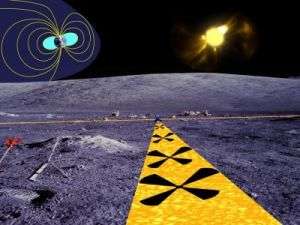Proposed astronomy missions selected for further study by NASA

NASA has awarded the University of Colorado at Boulder $1 million to lead the study of a space observatory to find Earth-like planets in distant solar systems and open the search for life outside our solar system.
A second proposal from the Naval Research Laboratory involving CU-Boulder also was selected for $500,000 in NASA funding. The proposal would place a low-frequency radio telescope on the far side of the moon to probe the first structures that formed in the early universe.
The CU-Boulder planetary proposal, called the New Worlds Observer, was one of 19 proposals for major new observatories in the coming decade selected for further study. The New Worlds Observer proposal features a giant, daisy-shaped plastic "starshade" to block starlight and allow a telescope to image the faint light from distant planets circling other stars, said Professor Webster Cash, chief scientist on the effort.
Astronomers will, for the first time, be able to identify planetary features like oceans, continents, polar caps and cloud banks and even detect biomarkers like methane, oxygen and water if they exist, said Cash, who is chair of the astrophysical and planetary sciences department. The 4-meter telescope planned for the project will be larger and more powerful than the 2.4-meter mirror on the Hubble Space Telescope, allowing researchers to record the light from rocky planets tens of trillions of miles away.
The telescope and its 50-yard-diameter starshade would launch into an orbit roughly 1 million miles from Earth, with the parasol unfurling and moving via thrusters into the lines of sight of nearby stars thought to harbor planets, said Cash. About 80 percent of the cost of the New World's Observer would go toward telescope development with 20 percent for the development of the starshade. "This observatory can be built today with existing technology," said Cash.
The Naval Research Laboratory-led proposal, known as the Dark Ages Lunar Interferometer, is for a low-frequency lunar radio telescope that would search for the faint hiss generated by pristine, primordial material as it formed the first stars and galaxies when the universe literally was still dark. CASA Professor Jack Burns and his colleagues will be developing a novel kind of radio telescope with elements embedded within plastic sheets. Astronauts could unroll the sheets on the far side of the moon, shielded from the interference of Earth-generated radio noise and with an unprecedented view of the sky.
Proposals by the 19 teams selected by NASA Feb. 15 will help guide decisions made during the Astronomy and Astrophysics Decadal Survey in 2010, led by the National Academy of Sciences to identify the most promising space observatory proposals. The 2008 NASA awards for the next-generation of astronomy missions ranged from $250,000 to $1 million each.
"New World Observer is a clean win for us because we got full funding and high ratings from NASA," said Cash. "This puts us on firm footing to compete with the other mission concepts for the right to build the next major observatory in space." The estimated cost to design and build the New Worlds Observer mission would be roughly $3.3 billion, said Cash.
Source: University of Colorado at Boulder




















